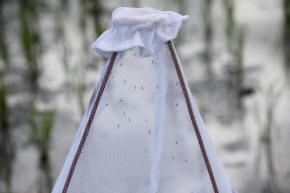New bed nets that 'ground' mosquitoes could boost malaria fight
 Send a link to a friend
Send a link to a friend
 [March 25, 2022]
By Jennifer Rigby [March 25, 2022]
By Jennifer Rigby
(Reuters) - Bed nets treated with a new
kind of insecticide cut malaria cases in children by almost half in a
large trial in Tanzania, according to a study in The Lancet, raising
hopes of a new weapon in the fight against the age-old killer.
Bed nets have been instrumental to the vast progress the world has made
in recent decades against malaria, with millions of lives saved. But
progress has stalled in the last few years, in part because the
mosquitoes which spread the infection have increasingly developed
resistance to the insecticide used in existing nets.
In 2020, 627,000 people died of malaria, mainly children in sub-Saharan
Africa.
Now, researchers at the London School of Hygiene and Tropical Medicine
in the UK (LSHTM), the National Institute for Medical Research and
Kilimanjaro Christian Medical University College in Tanzania, and the
University of Ottawa in Canada have shown that a new insecticide -- the
first in 40 years -- is both safe and effective in a real-world
randomized trial.

The nets, treated with chlorfenapyr as well as pyrethroid, the usual
chemical used, reduced malaria prevalence when compared with the
existing nets by 43% in the first year and 37% in the second year of the
trial. The study involved more than 39,000
households and followed over 4,500 children aged 6 months to 14 years
old. The nets, developed by BASF in Germany and LSHTM, are marginally
more expensive than the current nets, at around $3 per item, but the
researchers said the savings in preventing cases outweighed the initial
increased outlay.
[to top of second column]
|

Anopheles mosquitoes are seen in a net placed in a rice field during
a test in the use of drone technology in the fight against malaria
near Zanzibar City, on the island of Zanzibar, Tanzania, October 30,
2019. REUTERS/Baz Ratner
 Chlorfenapyr works differently than pyrethroid,
effectively grounding the mosquitoes by causing wing cramps and
making them unable to fly, and therefore bite, spreading the
infection. The chemical was first proposed for use against malaria
20 years ago, and has been used for pest control since the 1990s.
The World Health Organization has already
pre-qualified the use of the new nets, but the trial, funded by the
British government and the Wellcome Trust, could lead to more
widespread recommendations for their use.
"This is the first evidence in real-life conditions," Dr Jacklin
Mosha, the study's lead author from the National Institute for
Medical Research, Tanzania, told Reuters.
Alongside progress on a malaria vaccine, which was approved by the
World Health Organization last year, the team said the net could be
another tool in the malaria toolbox.
However, they warned that it is important to ensure that mosquitoes
do not also quickly develop resistance to chlorfenapyr, if used
widely.
(Reporting by Jennifer Rigby; editing by Michele Gershberg and
Jonathan Oatis)
[© 2022 Thomson Reuters. All rights
reserved.] This material may not be published,
broadcast, rewritten or redistributed.
Thompson Reuters is solely responsible for this content.
 |